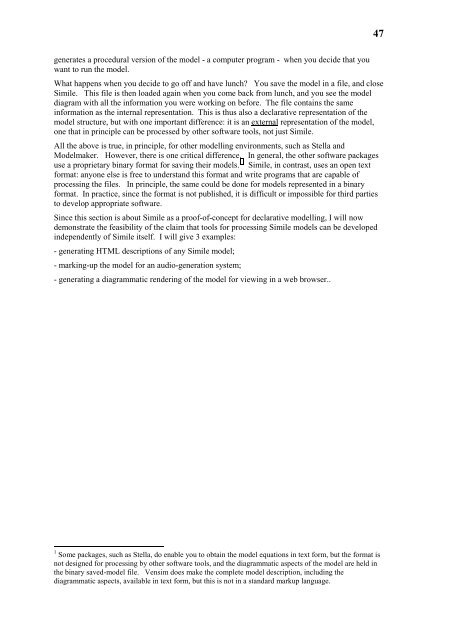pdf: 600KB - Potsdam Institute for Climate Impact Research
pdf: 600KB - Potsdam Institute for Climate Impact Research
pdf: 600KB - Potsdam Institute for Climate Impact Research
Create successful ePaper yourself
Turn your PDF publications into a flip-book with our unique Google optimized e-Paper software.
47<br />
generates a procedural version of the model - a computer program - when you decide that you<br />
want to run the model.<br />
What happens when you decide to go off and have lunch? You save the model in a file, and close<br />
Simile. This file is then loaded again when you come back from lunch, and you see the model<br />
diagram with all the in<strong>for</strong>mation you were working on be<strong>for</strong>e. The file contains the same<br />
in<strong>for</strong>mation as the internal representation. This is thus also a declarative representation of the<br />
model structure, but with one important difference: it is an external representation of the model,<br />
one that in principle can be processed by other software tools, not just Simile.<br />
All the above is true, in principle, <strong>for</strong> other modelling environments, such as Stella and<br />
Modelmaker. However, there is one critical difference. In general, the other software packages<br />
use a proprietary binary <strong>for</strong>mat <strong>for</strong> saving their models. 1 Simile, in contrast, uses an open text<br />
<strong>for</strong>mat: anyone else is free to understand this <strong>for</strong>mat and write programs that are capable of<br />
processing the files. In principle, the same could be done <strong>for</strong> models represented in a binary<br />
<strong>for</strong>mat. In practice, since the <strong>for</strong>mat is not published, it is difficult or impossible <strong>for</strong> third parties<br />
to develop appropriate software.<br />
Since this section is about Simile as a proof-of-concept <strong>for</strong> declarative modelling, I will now<br />
demonstrate the feasibility of the claim that tools <strong>for</strong> processing Simile models can be developed<br />
independently of Simile itself. I will give 3 examples:<br />
- generating HTML descriptions of any Simile model;<br />
- marking-up the model <strong>for</strong> an audio-generation system;<br />
- generating a diagrammatic rendering of the model <strong>for</strong> viewing in a web browser..<br />
1 Some packages, such as Stella, do enable you to obtain the model equations in text <strong>for</strong>m, but the <strong>for</strong>mat is<br />
not designed <strong>for</strong> processing by other software tools, and the diagrammatic aspects of the model are held in<br />
the binary saved-model file. Vensim does make the complete model description, including the<br />
diagrammatic aspects, available in text <strong>for</strong>m, but this is not in a standard markup language.
















